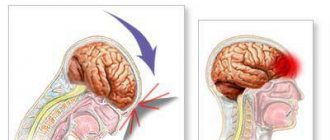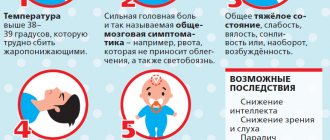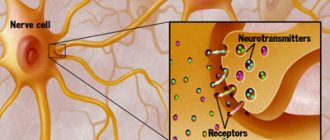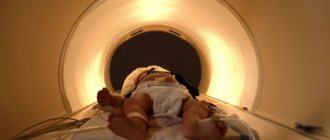Due to irritation of the meninges during infections of the central nervous system, cerebrovascular diseases, and traumatic brain injuries, meningeal syndrome occurs, which forms the basis of the clinical picture of any acute form of meningitis.
The localization of the pathological process and the age of the patient influence the severity of its individual components and the nature of clinical manifestations.
Symptoms of meningeal syndrome are an absolute indication for emergency hospitalization of the patient in a neurosurgical or neurological department, and in severe cases, in the intensive care unit of a hospital, since this is a very dangerous condition that is life-threatening.
Heat
The patient's temperature rises sharply - up to 40°C - and fever begins. This is one of the first signs of meningitis. An unfavorable symptom is body temperature below normal. There is also a localized form of meningitis, when the infected person himself is not sick, but is a carrier of the infection, or the disease is mild, resembling ARVI. Then the temperature reaches 38°C. Doctors recommend going to the hospital even if you suspect localized meningitis, as the disease can become severe.
Photo: spinoff.com
Position of a pointing dog with meningitis
One of the extremely unfavorable symptoms of meningitis. Observed in severe cases of the disease. The patient lies bent over, bends his legs at the knees and brings them to the stomach, presses his hands tightly to the chest, while throwing his head back.
Brudzinski's sign
The patient lies on his back. The back of the patient's head must be placed on your hand and carefully bend your neck, bringing your head to your chest. With meningitis, sharp pain appears, and the patient involuntarily bends his knees.
Due to irritation of the meninges, a person cannot reach his chin to his chest. This is how doctors detect stiffness of the neck muscles, that is, an increase in their tone.
In most cases, small children begin to cry in pain.
Kernig's sign
In the supine position, the patient bends his leg at a right angle. With meningitis, trying to straighten the knee joint will cause pain. Doctors allow the use of these methods until the ambulance arrives. It is recommended not to make sudden movements, paying attention to the patient’s reaction.
Rash on the body
This method of checking for meningitis is popular on the Internet. The patient is advised to press on the rash with a clear glass glass. If the skin turns pale, it means there is no meningitis. And if the rash is visible, the patient is infected.
Most often, meningitis is actually accompanied by a rash. However, our speaker strongly recommends against using such a check. Misinterpretation of this test will lead to dire consequences in wasting time.
Fear of light
Due to irritation of the lining of the brain, the patient experiences increased photosensitivity. This is one of the first signs. However, in the future, the patient may also be irritated by loud sounds and any touch to the skin.
Heat
The patient's temperature rises sharply - up to 40 o C - and fever begins. This is one of the first signs of meningitis. An unfavorable symptom is body temperature below normal.
There is also a localized form of meningitis, when the infected person himself is not sick, but is a carrier of the infection, or the disease is mild, resembling ARVI. Then the temperature reaches 38 o C.
Doctors recommend going to the hospital even if you suspect localized meningitis, as the disease can become severe.
Headache, vomiting
Meningitis is characterized by a sudden onset, and in most cases the patient immediately experiences headache and vomiting, and the skin turns pale.
Despite the different sensitivity thresholds, headaches with meningitis are always unbearable. There is general weakness, pain in the back and limbs. The patient constantly wants to drink and loses his appetite.
Signs also include lethargy, confusion, and difficulty breathing.
With meningitis, the clock counts. During the first 24 hours, there is a high probability of saving the patient. Therefore, if you notice several important signs, you should immediately consult a doctor. If you do not seek medical help in a timely manner, the mortality rate is more than 50%.
We contacted the Almaty Department of Public Health. Sanitary doctors told how to protect yourself from infection.
Last year, 35 cases were registered in the southern capital, of which 6 were fatal. Most often, children under 5 years old suffer from meningitis, since their immune system has not yet developed. Young people who spend a lot of time in nightclubs, cinemas and other places with large crowds of people are also at high risk of infection.
Sanitary doctors recommend ventilating rooms more often, walking more in the fresh air, and avoiding frequent trips on public transport. When coughing or sneezing, use disposable tissues. If you don’t have one at hand, sneeze into your elbow. Wash your hands thoroughly and frequently with soap and water for at least 20 seconds.
In connection with the upcoming month of Ramadan, health officials ask the imams of Kazakh mosques to take measures to create comfortable and safe conditions for prayer.
“Unfortunately, many parents do not fully understand the danger of the disease. They refuse qualified medical care. Meningitis is one of the ten most dangerous infections, be vigilant!” — added to the Department of Public Health.
source
Trigger position and glass: How to recognize meningitis?
There are several specific signs of a dangerous disease.
The causative agent of meningococcal infection is transmitted from person to person by airborne droplets (aerosol) through direct close communication, close contact (up to 1 m) with an infected person. Meningococcus is unstable in the external environment and its transmission through household items has not been registered.
The incubation period can vary from 1 to 10 days. Seek immediate medical attention if you experience the following symptoms:
- against the background of the usual manifestation of a cold, an intense headache appears, so strong that it worries more than all other symptoms,
- headache accompanied by nausea and vomiting,
- against the background of increased body temperature, pain in the back and neck, aggravated by moving the head,
- drowsiness, confusion, nausea, vomiting, convulsions of any intensity and any duration
- any rash due to fever,
- in children of the first year of life - fever, monotonous crying and bulging fontanel.
Doctors say: it is difficult for a person with meningitis to tilt his head forward. During sleep or in oblivion, the patient holds his head like this:
A simple test. It is enough to take a simple clean glass and press it to the body in the place where the rash appears. “Meningitis rash” not only has a characteristic appearance, but also does not disappear with pressure.
The symptoms are as follows.
Upper Brudzinski's sign . When raising the head from a supine position, the patient's legs spontaneously bend at the knees.
Körnig's sign : It is impossible to straighten the patient's leg at the knee joint if it is bent at the hip.
The disease can progress at lightning speed and result in the death of the patient. Any suspicion of the development of meningitis requires immediate hospitalization and careful medical supervision. Hospitalization is carried out in an infectious diseases hospital, where an initial examination of the patient is carried out and a diagnosis of probable meningitis is carried out.
If you notice these signs, call an ambulance immediately.
source
What are the meningeal symptoms and how to recognize them?
Brain diseases are characterized by the presence of specific symptoms, the basis of which is meningeal symptoms. These symptoms are the main evidence of the onset of serious changes in the nervous system, and the sooner the disease is recognized and treatment is started, the greater the chance of recovery without serious consequences.
The main thing is not to make mistakes...
It is no coincidence that meningeal signs have this name, since in the vast majority of cases the cause of their manifestation is meningitis. Its different forms are characterized by certain symptoms, but the basis is meningeal.
With meningitis, in addition to inflammatory processes in the brain, noticeable changes occur in the cerebrospinal fluid, and this is one of the features of the course of the disease. There are a number of causes that can cause symptoms similar to meningeal syndromes, but do not affect the spinal cord, in particular:
- excessive sunbathing
- excessive saturation of the human body with water (usually occurs after severe dehydration)
- severe infectious diseases (salmonellosis, typhoid, influenza)
- alcohol poisoning
- transient cerebrovascular accident (TCI)
- allergies
- brain tumors
- radioactive damage to the body
All of the above can cause the development of meningeal syndrome, but in this situation the treatment differs from the treatment of meningitis.
In addition, there is such a thing as “pseudomeningeal symptoms,” which occur in some diseases that are not associated with damage to the meninges (mental disorders, osteochondrosis). That is why it is important to take into account all manifestations and make the correct diagnosis.
Classification
It's time to look directly at the symptoms themselves, which are commonly called meningeal. The meningeal symptom complex includes:
- Kernig's sign
- Brudzinski syndrome
- headache
- vomit
- Bekhterev's symptom
- Gordon's reflex
- Guillain's reflex
- Le Sage syndrome
- stiff neck muscles
- presence of a “pointing dog” pose
- hyperesthesia
Brudzinski syndrome
Brudzinski meningeal syndrome has several variations, including:
Buccal – the doctor applies pressure to the patient’s cheek, resulting in involuntary flexion of the arms at the elbow joint, as well as a kind of shrug of the shoulders.
Lower - With the patient sitting, one of the legs is bent, the second automatically bends along with the first.
Upper – the patient’s head is tilted forward, and the legs are automatically bent.
Medium – when pressing on the patient’s pubis, the legs bend.
Often, Kernig and Brudzinski syndromes occur together in meningitis.
Headache
When meningitis occurs, headache accompanies the patient constantly and does not stop for a minute. It is one of the most pronounced meningeal symptoms.
Vomit
Gag reflexes can occur in a patient even in the absence of such manifestations as primary symptoms, such as nausea. Vomiting occurs suddenly against the background of a severe headache and is characterized by a gushing outpouring.
In some cases, there is a decrease in the intensity of headaches after bouts of vomiting.
Bechterew's syndrome
Meningeal ankylosing spondylitis is diagnosed by tapping the patient's cheekbone with a finger. This tapping causes a severe headache on the side of the face where there is inflammation, in addition, this side will curl up in a grimace of pain.
Gordon reflex
Gordon's meningeal syndrome is diagnosed by a neurologist as follows: the doctor wraps his hand around the patient's lower leg and applies strong compression. As a result, the patient's big toe unclenches, and the fingers also diverge in different directions.
Guillain reflex
The patient is asked to take a lying position, after which the doctor applies pressure on the front surface of the thigh of one of the legs or squeezes it. As a result, the opposite leg involuntarily bends at the knee.
Lesage syndrome
This symptom is typical for infants, and in most cases it is diagnosed in them. The patient lifts himself by the armpits above the floor, as a result of which the baby's legs involuntarily tighten (are pulled towards the chest).
Neck muscle stiffness
This condition is characterized by hypertonicity of the occipital and cervical muscles and manifests itself in the inability or difficulty in performing simple actions, such as turning the head or tilting it.
Often, muscle rigidity is characteristic of young children, but not as a symptom of meningitis, but due to the fact that the peripheral nervous system is not fully formed. Therefore, it is extremely important to diagnose the disease comprehensively and be based on several factors.
Pointing dog pose
In some sources there is such a name as the “cocked hammer” pose. It manifests itself as follows: the patient throws his head back, the torso is tense and elongated, the arms are pressed tightly to the chest, the legs are also pulled up to the thoracic region.
Hyperesthesia
Meningeal hyperesthesia syndrome, or increased light and noise sensitivity, manifests itself in the form of painful perception by the patient of bright light and loud sounds. For this reason, the patient is recommended to stay in a darkened room and, if possible, completely eliminate irritating sounds.
Features of the course of the disease in children
As for children, at an early age it is difficult to diagnose the disease based on meningeal symptoms, since most of them do not appear.
The main symptom characteristic of children is Le Sage syndrome, as well as a severe headache, against the background of which the child becomes irritable, refuses to eat and develops apathy.
Rare species
Modern neurology, in addition to the above, there are other meningeal syndromes, however, their manifestations are rare, these include:
- Levinson's sign (opening of the mouth when trying to touch the chin to the chest).
- Perrault's sign (pupil dilation with any pain).
- Mendel's sign (pressure on the eyeballs or ears causes pain).
Thus, as soon as meningeal syndrome manifests itself in a patient, the patient must immediately take measures to contact a specialist and begin treatment as soon as possible, since in addition to mild forms of meningitis, there is a possibility of developing acute forms of meningitis, which can be fatal.
source
Meningitis #3
This post is for informational purposes only. There are no stories in it. I continue to talk about meningitis.
Depending on the etiology, that is, on the causes that provoked meningitis, this disease can be infectious, infectious-allergic, microbial, neuroviral, traumatic or fungal.
Microbial meningitis, in turn, can manifest itself in the form of serous meningitis, tuberculous meningitis, influenza or herpetic meningitis. Accordingly, the clinical manifestations will be different. Of course, there are also common signs - the so-called meningeal signs.
We will talk about them today. In the future, when describing any type of meningitis, I will refer to this post.
The topic of today's post is “Meningeal signs (symptoms)”
.
Koernig's sign
. It consists of the inability to straighten the patient’s leg at the knee joint when it is bent at the hip. It is not pain that interferes with extension, but tension in the posterior thigh muscles (tonic sheath reflex). It is one of the most common and persistent symptoms of meningitis.
Source: https://geraklionmed.ru/polozhenie-legavoy-sobaki-pri-meningite/
Complex of reasons
Meningeal syndrome appears due to the development of an inflammatory process with tissue swelling and increased intracranial pressure, irritating the nerve endings of the meninges.
Meningitis, depending on the etiology, can be:
- bacterial (pathogens: meningococcus, pneumococcus, tuberculosis and hemophilus influenzae):
- viral (pathogens: coxsackie enteroviruses, ECHO infections, mumps);
- fungal (pathogens: candidiasis, aspergillosis, cryptococcosis);
- protozoan (pathogens: toxoplasmosis, cysticercosis, amoebiasis);
- rickettsial (pathogens: typhus, tick-borne fevers).
There are primary meningitis, which develops without previous signs of a pathological process, and secondary, when damage to the meninges begins after other manifestations of infection.
The causative agent of meningitis penetrates the membranes of the brain through the blood (hematogenous), with the flow of lymph through the lymphatic vessels, or spreads from purulent foci located on the head, for example, with otitis, osteomyelitis, mastoiditis.
The waste products of meningitis pathogens, through their toxic effects, disrupt the microcirculation of the cerebral circulation and liquor dynamics, which leads to the development of edema and displacement of brain structures, the development of secondary stem syndrome, and disruption of life support functions.
Article on the topic: Albright syndrome - description and causes of the disease, diagnosis, treatment methods and possible complications
Concept of meningeal syndrome
The manifestation of meningeal syndrome is cerebral, general infectious and meningeal symptoms themselves, along with impaired liquor dynamics and inflammatory changes in the composition of the cerebrospinal fluid.
General cerebral symptoms are a specific reaction of the nervous system to the processes accompanying inflammation of the meninges; they develop as a result of irritation of the endings of the cranial nerves, autonomic centers, and blood vessels.
With any meningitis, symptoms characteristic of most infectious diseases are always present. Meningeal symptoms themselves are manifested by increased sensitivity to external stimuli, muscle tension, and changes in reflexes.
The inflammatory process is reflected in the composition of the cerebrospinal fluid; only laboratory testing can confirm the final diagnosis of meningitis. Swelling of the meninges and damage to the perineural spaces causes disturbances in cerebrospinal fluid dynamics with hypersecretion and difficulty in the absorption of cerebrospinal fluid.
Features of the development of the syndrome in children
In newborns, the syndrome most often occurs against the background of a perinatal infection of the central nervous system, when the fetus is infected during intrauterine development, during birth or after birth.
In children, specific meningeal symptoms are absent or mild:
- the most characteristic sign is bulging and tension, in some cases, sinking of the large fontanel ;
- symptoms of central nervous system depression are clearly expressed - general lethargy, drowsiness, suppression of reflexes, including sucking and swallowing, a sharp decrease in motor activity, weak reaction to the environment, severe muscle hypotension;
- there is hypertensive syndrome - hyperesthesia of the skin and head, tremor of the chin and limbs, irritated, painful cry;
- there is dysfunction of the brain stem , manifested by disturbances in the rhythm of breathing, pupillary reflexes, and oculomotor disorders;
- when lifting a child by the armpits, involuntary flexion of the legs at the knee and hip joints occurs and holds them in this position - Lesage's symptom ("suspension").
Meningeal symptoms (signs) in adults and children. Meningism. Causes, symptoms, clinic
Meninges.
Source: ru-babyhealth.ru Meningeal symptoms (also known as meningeal signs) are symptoms of irritation of the meninges and the cause of the formation of a symptom complex called meningeal syndrome in neurological practice.
Meningeal syndrome due to meningitis
The importance of its timely detection in meningitis is high.
Its presence is a “red flag” for the doctor and a matter of excluding or confirming its infectious nature.
The symptoms of meningitis were first described by Hippocrates, but the first documented outbreak of the disease occurred in Geneva (1805). Later (1830) it broke out in North America, and 10 years later - in Africa. In the Russian Empire, epidemic meningitis was recorded in 1863 in Kaluga, and in 1886. in Moscow.
Meningeal syndrome covers symptoms (s) of damage to the meninges, both inflammatory and infectious and non-inflammatory in nature.
Causes of inflammatory infectious lesions:
- Bacteria (meningococcus, pneumococcus, group B streptococci, listeria, M. tuberculosis, Haemophilus influenzae);
- Viruses (enteroviruses, arboviruses, cytomegalovirus, HSV type 1, type 2);
- Fungi (Candida, cryptococcus);
- Spirochetes (Treponema pallidum, Borrelia, Leptospira).
Causes
What diseases cause irritation of the meninges:
- Hemorrhage into the membranes of the brain during hemorrhagic stroke (intracerebral hemorrhage), traumatic brain injury (intracranial hemorrhage: subarachnoid, subdural, epidural);
- High intracranial pressure (ICP) due to hydrocephalus, abscess - any space-occupying formations (cysts, tumor);
- Intoxications: a) exogenous: alcohol, abuse of various chemicals, work in paint factories; b) endogenous: hypoparathyroidism, poisoning of the body with products of protein metabolism due to impaired renal function.
- Tumor metastases to the meninges
- Meningitis of any origin. Why it’s dangerous read here
Symptoms of meningeal irritation
- headache accompanied by nausea/vomiting, often diffuse and more pronounced in the frontal and occipital parts
- stiffness of the neck muscles, Kernig and Brudzinski syndromes
- increased sensitivity to external stimuli (sound, light, etc.)
), - heart rhythm disturbances (with the development of both tachycardia and bradycardia)
- “pointing dog” pose (the torso is extended, the head is thrown back, the “scaphoid” stomach is retracted, the arms are pressed to the chest, and the legs are drawn to the abdominal area - an involuntary position of the body).
- impaired consciousness - in severe cases
- decreased/absent tendon and abdominal reflexes
Vomiting (not associated with food intake) and bradycardia - due to irritation of the vagus nerve with its nuclei or the vomiting center of the reticular substance of the medulla oblongata.
Intense headache, tachycardia, vomiting are general cerebral symptoms indicating increased ICP and changes in the composition of the cerebrospinal fluid.
about what cerebrospinal fluid (CSF) is and how it is examined here
Both types of heart rhythm disturbances: tachycardia and bradycardia occur when the meninges are irritated.
Meningeal signs: what are they and how to check for them?
Meningeal sign: Kernig's sign.
For timely diagnosis in neurology, the doctor must know meningeal syndrome, imagine what it is and how to check for its presence when examining the patient.
If meningeal signs are negative, the diagnostic search for the causes of the disease continues in other directions. In medical documentation, their absence may be referred to as abs.
If they are positive, the examination reveals the following signs:
Meningeal symptoms by author:
- Rigidity of the neck muscles due to tense neck muscles at the back when the doctor tries to bend the patient's head forward.
A characteristic tilting of the head appears. Any attempt to change a fixed position causes pain. In this case, the distance from the chin to the sternum is indicated in centimeters or in the diameter of the index finger of an adult (pp). - Kernig's sign (S-m) is an important sign that appears early: the patient, who is lying on his back, bends his leg at an angle of 90 degrees at the hip and knee joints and tries to fully straighten it at the knee.
But there is pain and reflex irritation of the leg flexors, which prevent extension. - Brudzinski's symptoms:
– Buccal – pressure is applied to the cheek of the subject and the arms are bent at the elbows absolutely involuntarily; the patient also shrugs his shoulders.
– Upper – the doctor tries to bend the patient’s head and at the same time the legs of the patient are bent and pressed against the stomach.
– Medium – while pressing on the pubic area, the patient’s legs bend.
– Lower – the examiner bends the patient’s leg in 2 joints (knee, hip), the other leg repeats the movements.
- S-Ankylosing spondylitis - when you tap your finger on the cheekbone, a sharp headache and a painful grimace appear - contraction of the facial muscles on the same part of the face.
- S-Gordon - the doctor grabs the patient’s shin and squeezes it tightly, as a result of this the big toe unclenches, the fingers move in different directions.
- S-Guillain - the doctor presses/squeezes the surface of the patient’s thigh (front) and the leg on the other side bends at the knee.
- S. Kerera : when palpating the exit points of the trigeminal nerve, the pain intensifies.
- Herman's sm : the examiner tilts the subject's head forward and the patient, who lies on his back with straight legs, extends his big toe.
- Sm Lafora : facial features become sharper.
- S-Flatau : the pupils dilate when the examiner tries to tilt the subject’s head forward.
- Bickel's method : the subject is asked to bend his arms at the elbows and not resist the examiner, however, passive extension of the arms cannot be carried out due to resistance.
- S-Mandanesi – the facial muscles tense when pressing on the eyeballs.
- Levinson's method : when the patient tries to tilt his head forward, his mouth opens.
Meningeal symptoms (signs) in children and newborns
“Spotting dog” pose for meningeal syndrome.
There are certain features in the manifestation of meningeal symptoms in children. As Bekhterev once noted, in newborns Kernig’s syndrome is physiological. It appears a few hours after birth, and is pronounced in the first month of life, and disappears only by the end of the 3rd (rarely 6th) month.
In children under 3 years of age, a pronounced picture of meningeal syndromes is rare.
The presence of headaches in infants can only be judged by the child’s general restlessness and crying (monotonous for no reason or screaming during sleep). Vomiting occurs (involuntary or when changing body position).
Characteristic symptoms of increased ICP in infants include protrusion, tension of the fontanelles, weak pulsation and their absence.
In children under 3 years of age, just like in adults, stiff neck muscles occur, according to Kernig and Brudzinsky.
A distinctive symptom is Lessage or “suspension”: the child is taken by the armpits, the head is supported from behind with the index fingers, and the child is lifted up (positive if the legs are involuntarily pulled towards the stomach and are fixed in a bent state for a long time). Meningeal syndromes in children over 3 years of age are no different from the same syndromes in adults.
Differential diagnosis of the syndrome
Differential diagnosis of meningeal syndrome is carried out taking into account the entire set of epidemiological and laboratory data.
Laboratory testing of the composition of the cerebrospinal fluid during a lumbar puncture is crucial in confirming the diagnosis.
Based on its results, conclusions are drawn about the nature and intensity of the inflammatory process, and the dynamics of development and course are predicted. The composition of inflamed cerebrospinal fluid can be purulent, serous, serous-fibrinous and hemorrhagic.
What is important is cytosis (increased content of cellular elements) and its nature in a certain volume of liquid, the concentration of sugar and chlorides in the cerebrospinal fluid.
The peripheral blood picture shows significant leukocytosis, absence of eosinophils, and increased ESR.










